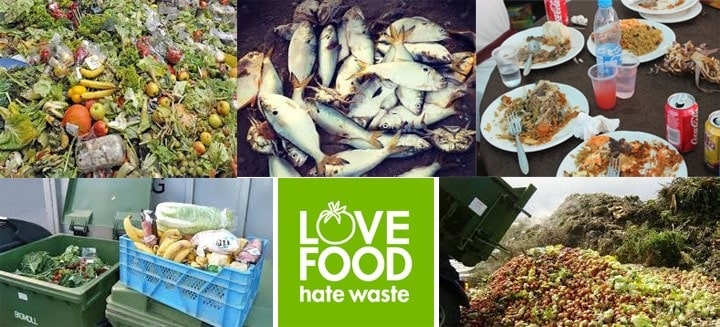The recent announcement by Ram Vilas Paswan, India’s Minister for Consumer Affairs about India’s first attempt to curb food wastage turned several heads. Paswan’s disclosure comes at a moment when India is trying to gatecrash into the elite club of developed nations. Sceptics in India view the curbs on portions served at chic restaurants as infringement of rights.

France became the first country in the world to ban dumping or destroying food products by stores and supermarkets. The law passed in 2024 penalizes stores found wasting food. France wasted 7.1 million tonnes of food every year. Of this, 67 percent was thrown away by consumers, 15 percent by restaurants and 11 percent by stores. Such food is now donated to charities.
UK households dumped seven million tons of food in 2024. Reports indicate, preventable food wastage from British households accounted for some 17 million tons of carbon dioxide emissions every year.
Germany is moving towards outlawing food wastage. Steps to eliminate all food wastage by the year 2030 are already being taken by the German government.
Shockers: Global food wastage
The Food and Agriculture Organization of the United Nations states, about one third of the food produced in the world for human consumption every year — approximately 1.3 billion tons — gets lost or wasted.
Food losses and waste amounts to roughly US $680 billion in industrialized countries and US $310 billion in developing countries. Added up, it means a dizzying US $990 billion dollars of food is wasted worldwide every year. In 2010, the Food and Agricultural Organization of UN estimated that one in every seven people on Planet Earth sleeps hungry daily.
More shockers: Criminal waste of food
The FAO has some more startling figures. It estimates that food wasted in Central and South America (Latin America) could have been used to feed 300 million people. More shockingly, food wasted in Africa could feed another 300 million hungry bellies. Food wasted in Europe would be sufficient to feed another 200 million people. In brief, food wasted in these regions would easily suffice all the hungry.
Worldwide, nearly 800 million people are starved. Of these, an estimated 200 million or a shameful 25 percent, are in India.
Reasons why people are forced to starve
Poverty: The American state, New Mexico recently enforced a law banning school children from being ‘lunch shamed.’ The practice involved throwing away a hot meal served to a student because his or her parent was unable to pay the lunch bill. Invariably all ‘lunch shamed’ children were from poor families. Schools who ‘lunch shame’ a child now are liable to be prosecuted. Poverty remains the single largest cause of global hunger, including in developed countries.
Wars and conflicts: Several parts of the world- Somalia, Iraq, Syria, for example are witnessing conflict. Economies of strife-torn countries lie in shambles. Law and order is non-existent or, at best, unpredictable. Despite best efforts by the UN, various governments and charity organizations, food supplies to the populace remain scarce. People in war ridden areas survive on scant local produce.
Natural calamities: Despite advanced disaster mitigation techniques, parts of the world struck with natural calamities face the stark prospect of starvation.
Improper food handling: Accounts for bulk of the food wasted worldwide. Reasons include lax stock keeping, lack of proper logistical cold chain, burgeoning fuel costs, erratic irrigation and unpredictable prices. Examples include India and the Indian subcontinent, Far East, Africa and South America.
Food inflation: The bane of the developing world, food prices are on an upward swing due to several reasons. Crop losses due to bad weather (draught or famine), rising cost of fuel and transportation as well as lack of logistics has caused more demand than supply.
- Stores and supermarkets throw away food products that have crossed the ‘Use Before’ date.
- Restaurants throw away stale food and leftovers of customers.
- Consumers waste food by disposing unspoilt leftovers caused by cooking more than they can eat. In some cultures, leaving a sizeable portion of food on the plate unconsumed is part of tradition.
Wasted food means wasted resources
Billions of dollars worth resources are flushed down the drain on account of wasted food. Various international organizations and governments are at loss to calculate the estimated losses. Resources in which precious money is lost include water, fertilizers, gasoline and other fossil fuels, electricity and manpower, to name a few.
Everyone from food producers to end consumers stand guilty of food wastage and for wasting trillions of dollars worth resources.
Preventing food wealth while generating wealth
These facts and figures are clear pointers that food wastage can be prevented. It also means saving precious of dollars while making money.
In developing countries, 33 percent of cereals, which can make over 750 boxes of pasta are wasted.
In Europe, about 20 percent of dairy products are lost annually.
The world accounts for 35 percent of losses of seafood. Around eight billion tons of trawled fish are dumped back into the ocean either dead or permanently maimed.
Worldwide, a whopping 45 percent of fruits, vegetables, roots and tubers farmed are lost due to lack of proper logistical support including cold chains and food processing units.
Wastage of meat worldwide amounts to a stunning 20 percent of all production, again due to insufficient cold chains.
Another 20 percent of oilseeds and pulses are lost worldwide every year. These losses are accrued due to improper storage and lack of processing units.
30 percent of food served at restaurants and eateries worldwide is dumped as garbage.
Restaurants themselves throw away large quantities of uncooked food. These losses are again caused by improper storage. Bread trimmings are disposed off instead of being converted as bread crumbs to be used in frying.
Supermarkets and shops account for unspecified volumes of food losses. They throw away expired and near expiry food products. This loss occurs due to the absence of proper inventory systems.
Investment opportunities in the food chain
Food storage facilities: Small and medium investors can reap rich dividends by opening warehousing facilities for storing grains, cereals and pulses. Most developing countries offer incentives for domestic and foreign investors in the logistics chain.
Cold chain logistics: These are vital for dairy products, meat, fruits and vegetable storage. Cold chain also involves reefer containers and trailers to ferry them. Cold chain logistics will play an important role in future of the food industry. Several countries are regulating food supplies. Cold chains will be decisive in determining which company makes the most of its produce.
Food Processing Units: There is a pressing need worldwide for more food processing units. The quantity of food wasted every year can be curtailed if not prevented fully through food processing. Processed foods are easily transported.
Reprocessing units: Oil and other discarded food items are increasingly recycled nowadays. Oil discarded from restaurant kitchens is converted into fuel and engine lubricants in some developed countries. The concept is yet to catch up in the developing world.
Composting units: Regardless of whatever is done, food wastage from home and restaurant kitchens is inevitable. Composting for fertilizer provides an ideal solution. A bag of compost retails at around US$ 2 each. In some countries it costs up to US$4 each. The cost of setting up composters and collection units is not as high as the other options listed.
Saving food to save costs
Restaurants and households can prevent losses of food in several ways, thus lowering their expenses
- Restaurants require proper inventory control. Keeping stock of what comes in and is used will help eliminate wastage of dairy and poultry products, meat and seafood and cooked food.
- Resizing portions, offering discounts to customers for consuming all food served is known to reduce wastage.
- Bones from poultry and meat are useful to make stocks used as base for soups.
- Bread trimmings leftover after fixing sandwiches can be ground into bread crumbs used for frying.
- Reducing the quantity of oils and sauces used in cooking, adds to the savings.
- Maintaining proper temperatures of refrigerators, cold chests and deep freezers
Household will find it easier to reduce food costs
- Maintaining proper inventory to prevent cooked food and raw materials from crossing the expiry date.
- Cooking only the required quantity.
- Taking inventory of existing stocks of food items before shopping.
- Buying smaller packs of all food items: More can be bought anytime if needed.
Worldwide, unique ideas at preventing food wastage to earn money are being tried and tested. Some of these novel ideas included:
- Fermenting discarded fruits, vegetables, cereals and grains to make liquor and beer.
- Using wasted food in fishponds.
- Conversion of wasted food into pellets for feeding poultry and livestock.
- Making cloth from casein in surplus milk.
These efforts, though novel, are in infancy stage due to lack of technology for industrial scale deployment. As the world awakens to the growing menace of food wastage, more innovative ideas that can be used on massive scale, are expected to be developed.
Pritam Nagrale, a digital marketer and Generative AI enthusiast, embarked on his journey with affiliate marketing in 2004. With over 14 years of blogging, he has turned his passion into a fortune, profoundly impacting the digital landscape. Through his expertise, Pritam has guided thousands to monetize online and achieve their dreams, establishing himself as a beacon for aspiring digital entrepreneurs.







